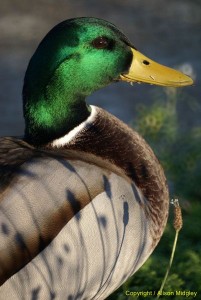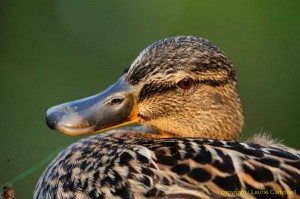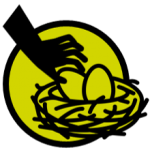 It may be appropriate to have the mallard duck as bird of the month since the shooting season for wildfowl, which includes the mallard, came into force on 1 September. The mallard is the most common wild duck, and can become extremely tame if in regular contact with humans, especially if being fed. The drake is a beautiful multi-coloured bird, with a yellow/green beak, bright orange legs, a grey body and a chestnut breast which is generally separated from a bottle green head by a narrow white band. In contrast the female – the duck – is a rather plain brown with a blue wing bar, a yellow/brown beak, though with the same bright orange legs. In common with most female birds, the duller plumage is as camouflage if sitting on a nest.
It may be appropriate to have the mallard duck as bird of the month since the shooting season for wildfowl, which includes the mallard, came into force on 1 September. The mallard is the most common wild duck, and can become extremely tame if in regular contact with humans, especially if being fed. The drake is a beautiful multi-coloured bird, with a yellow/green beak, bright orange legs, a grey body and a chestnut breast which is generally separated from a bottle green head by a narrow white band. In contrast the female – the duck – is a rather plain brown with a blue wing bar, a yellow/brown beak, though with the same bright orange legs. In common with most female birds, the duller plumage is as camouflage if sitting on a nest.
Ducks can lay eggs as early as January, though because of adverse weather, early ducklings are less likely to survive. The normal time for a duck to begin to lay is around early March. Eight or nine eggs is the normal clutch, though it is not unknown for more than one duck to lay in the same nest and a large brood of ducklings can result. The duck pulls soft grey down from its breast to line the nest, and carefully covers the eggs with the down when it leaves the nest to feed, usually at fist light and in the early evening. Covering the eggs makes them less vulnerable to avian predators, such as crows and gulls.

Around 28 days after they are laid, the eggs hatch into yellow and black ducklings, which the mother normally broods for about 24 hours to allow the ducklings to dry. When they leave the nest they rather resemble outsize furry bumble bees. When hatched they are still vulnerable to predation, with mink, otters and pike joining the avian predator band. A duck is lucky if all ducklings hatched survive to the flying stage.
Legal wildfowling aside, of late, humans have been added to the ducks’ predators. It has unfortunately become quite common for ducks, especially the semi-tame ones on rivers, lochs, lakes and ponds, to be deliberately caught in nets or by other illegal means. There is little doubt that this is a growing method of poaching where the unfortunate victims are destined for the pot.





